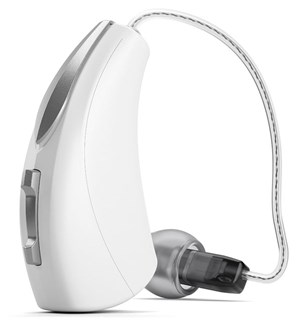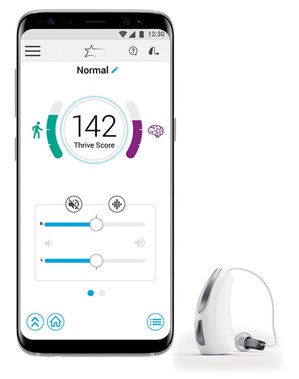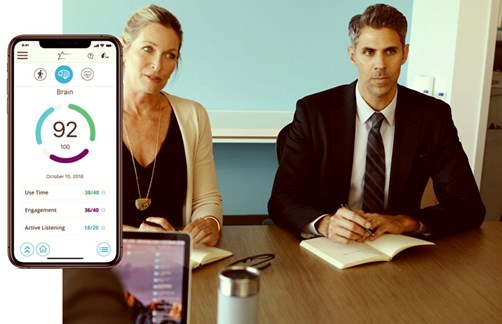A hearing aid? A Fitbit? A falls alert device? A ‘Healthable’? Achin Bhowmik discusses how Starkey’s Livio AI came to market and what it means for the future of amplification devices.

Achin Bhowmik.
Achin, you have an interesting background in computing and engineering. How do you think your background at Intel has shaped your focus for this new technology?
All my life, I’ve been passionate about developing perceptual computing technologies, such as sensors and artificial intelligence. My focus at Intel was to use these technologies to make more intelligent machines. That was an incredible time in my career as the world is getting smarter and there is so much to explore and invent. But Starkey CEO, Mr Austin came to me and asked, “Do you want to use the same advanced technologies, but instead of focusing on making more intelligent machines, help people perceive and understand the world better?”
“I made the move from working to enhance machine perception, to working toward augmenting human perception”
That was a life-changing conversation – to work for Starkey and use new technologies to redefine what a hearing aid is, and to help more people lead better, more fulfilling lives. So, I made the move from working to enhance machine perception, to working toward augmenting human perception. This is a tremendous opportunity to push the frontiers of technologies that enhance and augment the processes of human sensation and perception.

Livio AI - the world’s first hearing aid with integrated sensors and artificial intelligence.
Who came together to make the device?
It’s been an incredible couple of years and it took Starkey’s CEO, Bill Austin’s vision, the leadership of Starkey President, Brandon Sawalich, and all of the Starkey team to make Livio AI a reality. We introduced Livio AI in the US and Canada in August 2018, but it is now in the process of launching around the world. We have literally been travelling the globe and we’ve been in awe of the dedication and excitement of our employees in the 25+ facilities worldwide.
What was your biggest challenge in bringing this device to market?
One of our biggest challenges in the hearing industry is the stigma surrounding hearing aids. According to the World Health Organization, 466 million people are in need of hearing aids around the world, yet only about 15 to 16 million hearing aids are sold each year. MarketTrack 10 states users wait an average of four years to talk to their doctor, and six years to get their first hearing aid.
Our hope is that by making the hearing aid a multipurpose device with cutting-edge technology and features, we can help consumers get past the stigma and start living better, longer, healthier lives. We are excited about the amazing language translation and virtual assistant features built into Livio AI, which bring the world of information to the user with an intuitive interface.
The big marketing focus of Livio AI has been the health monitoring aspects. What sensors have been added to the hearing aids to run these features?
The integrated 3D motion sensors inside Livio AI enable the hearing aids to detect movement, track activities, and recognise gestures. The hearing aids communicate with each other and Livio AI’s ecosystem of compatible mobile accessories to deliver meaningful, real-time feedback about users’ overall physical and cognitive health and fitness.
Adding sensors to the device helps it imitate the human perceptual system. Using embedded 3D sensors, Livio AI is able to replicate the human vestibular system, which is responsible for balance and spatial orientation. It uses artificial intelligence to enable the hearing aids to perform tasks that normally require human intelligence. This allows people to take a proactive and personal approach to treating hearing loss, which has been linked to various health issues including dementia, cognitive decline, anxiety, stress, social isolation and an increased risk of falling.
As of February 2019, Livio AI now includes additional groundbreaking advancements, powered by artificial intelligence and integrated sensors. To me, the most life-changing one is Fall Detection and Alert. Fall Alert is able to automatically identify if the user falls and send alert messages to a selected number of contacts. We incorporated significant new inventions to avoid false-positives and flag only true falls. We are thrilled to be able to use technology to give millions of people, their families and caregivers peace of mind.
So, I have a smart phone, a smart watch; why do I want these sensors in a hearing aid – what makes my ear the place to be?
The ear is the new wrist, and more! If you think about it, the ear is where paediatricians get a child’s temperature. It’s an ideal spot to measure heart rate and equilibrium, which is how Livio AI also provides fall detection. Your ear provides more information about what’s going on within your body and the brain than your wrist. The possibilities are endless!
So, I’m still using the phrase ‘hearing aid’ although occasionally I use ‘amplification device’ but neither of those phrases really sits well – with all this tech, what should we now be calling the new devices to the market?
Absolutely, you’re right, this is no longer just a hearing aid and it definitely is not just a sound amplification device – it is so much more! Livio AI starts a new era for the hearing industry. We call the Livio AI a HealthableTM device.
First and foremost, Livio AI is the best hearing aid we have ever made in terms of sound quality. The piece that is so exciting to me is that it’s the world’s first multipurpose hearing aid. Hearing aids were already great devices when compared to other consumer electronics. They have ergonomic designs for comfortable all-day use, great multiday battery life, and allow you to control the volume of the world – truly a super-human capability. For hearing-impaired people, they allow enhancement of one of the most important sensory gateways to the world and help connect with people. However, hearing aids have so far been a single-purpose device; they have been a device used to amplify sound. Livio AI changes all of that. This is the hearing industry’s iPhone moment.
Before the iPhone, you used your phone to, well, make phone calls. Now your phone is your fitness tracker, camera, GPS, and your device to access the internet. Thanks to built-in sensors, it has truly become a must-have device with so many functions. With Livio AI, our product is no longer just an amazing hearing aid, it’s now also the world’s first hearing aid to feature integrated sensors and artificial intelligence and be able to respond to your tap gestures and track your brain and body health. It is the first device to track physical activity and cognitive health as measured by the hearing-aid use in social situations. This lets patients take a proactive and personalised approach to their health through their hearing aids. Like we talked about, the ear is a sweet spot for reliable tracking of health data, so the possibilities are endless. On top of it all, Livio AI also has in-ear language translation and automatic fall detection capabilities.

The Thrive Hearing App is an app available on the iPhone that connects to Livio® AI hearing aids
and features such components as remote programming, personalised memories, and transcription.
So, let’s talk about the app side of things, what’s in there to help with the rehabilitation side of adjusting to hearing devices?
The ThriveTM app is a tool for both patients and hearing professionals. For the hearing professional, the key feature is Hearing Care AnywhereTM. It allows for a patient to request changes from the professional who can then make them remotely – eliminating the need for an additional appointment and saving both the patient and the professional valuable time, as well as allowing for optimal performance of the hearing aids with minimal effort. For the patient, there is Self-Check, which can help a wearer troubleshoot issues and personalise controls to allow for real-time adjustments. It also has a remote control which can change the volume and switch memories from the patient’s smartphone as well as a Find My Hearing Aids option – the list goes on!
At a time when hearables, PSAPs and the OTC debates are dominating the audiology chatter, where does this device fit into Starkey’s portfolio?
Livio AI really embodies how much more there is to hearing aids than the amplification of sound. At Starkey Hearing Technologies, our mission is to help people hear better and live better. We know hearing loss is connected to a number of significant health issues, including dementia, depression and cardiovascular disease. Livio AI goes beyond better hearing and patients should be able to expect that from a hearing aid – they will be blown away by what their hearing aids can do for them.

Visit the online version of this article on our website to watch this video, which explains more about the Thrive App.
Where do you see the future of hearing products?
We are just getting started! The possibilities of what a hearing aid can do are endless. We will continue to break down the stigma around hearing aids, and we will continue to make the impossible possible and create groundbreaking technology that will help our patients live better, more fulfilled lives.







